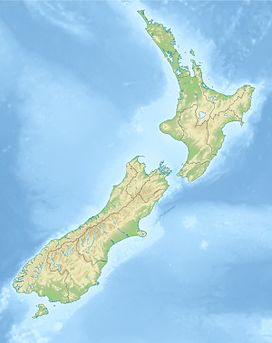Mount Adams, New Zealand
| Mount Adams | |
|---|---|

Mount Adams from the south-east, Escape Glacier at left, Siege Glacier (partially covered in rock debris) at centre. Late summer conditions.
|
|
| Highest point | |
| Elevation | 2,208 m (7,244 ft) |
| Prominence | 754 m (2,474 ft) |
| Coordinates | 43°06′02″S 170°31′40″E / 43.1005°S 170.5277°ECoordinates: 43°06′02″S 170°31′40″E / 43.1005°S 170.5277°E |
| Geography | |
|
|
|
| Parent range | Southern Alps |
| Topo map | Topo50 BW17 - Harihari NZMS 260: I35 Whataroa |
| Climbing | |
| Easiest route | New Zealand Alpine Grade 1 |
Mount Adams is a mountain in the West Coast region of New Zealand's South Island. The summit is roughly 19 km south of Harihari and reaches 2,208 metres (7,244 ft) in height.
Mount Adams lies to the west of the main divide of the Southern Alps and drains into the Whataroa and Poerua catchments. Both of these rivers flow westwards to the Tasman Sea. There are two small glaciers on the south-eastern slopes that drain the summit ice cap; the Escape Glacier (about 2.1 km in length) and the Siege Glacier (about 3.6 km).
This area, like much of the West Coast region, is subject to high precipitation by world standards. There are no rainfall gauges on Mount Adams, but a gauge in Whataroa valley at the State Highway 6 bridge 10 km south-west of the summit at 60 metres above sea level, records a mean annual rainfall of 5690mm (224 inches) and daily falls of up to 320mm (12 inches). It is likely that the precipitation at higher elevations on Mount Adams will be significantly greater than this, and a rain gauge in the Cropp River 42 km north-east of Mount Adams at 860 metres above sea level, records a mean annual rainfall of 10,690mm (421 inches) and daily falls of up to 695mm (27 inches).
The Alpine Fault runs across the lower North-western slopes of the mountain near the edge of the coastal outwash plain, and is the boundary between the Pacific and Indo-Australian tectonic plates. Mount Adams itself is composed primarily of schist of Permian–Triassic (depositional) age, which is increasingly metamorphosed closer to the Alpine Fault.
...
Wikipedia

